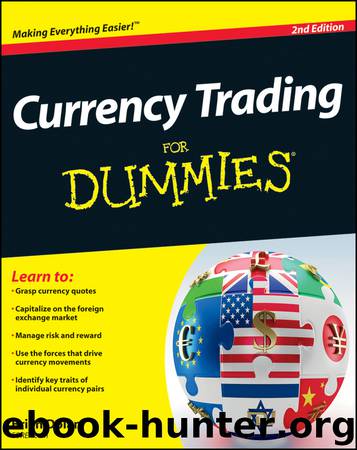Currency Trading For Dummies by Brian Dolan

Author:Brian Dolan [Dolan, Brian]
Language: eng
Format: epub
Publisher: John Wiley & Sons, Ltd.
Published: 2011-06-05T14:00:00+00:00
Source: www.eSignal.com
Monitoring EUR/JPY and other JPY crosses
USD/JPY is heavily influenced by cross flows and can frequently take a back seat to them on any given day. In evaluating USD/JPY, I always keep an eye on the JPY crosses and their technical levels as well. A break of important support in GBP/JPY, for instance, could unleash a flood of short-term USD/JPY selling, because GBP/JPY is mostly traded through the dollar pairs.
EUR/JPY is the most actively traded JPY cross and its movements routinely drive USD/JPY on an intraday basis. Be alert for when significant technical levels in the two pairs coincide, such as when both USD/JPY and EUR/JPY are testing a series of recent daily highs or lows. A break by either can easily spill into the other and provoke follow-through buying/selling in both.
The Other Majors: Sterling and Swissy
The other two major currency pairs are GBP/USD (affectionately known as sterling or cable) and USD/CHF (called Swissy by market traders). These two are counted as major currency pairs, but their trading volume and liquidity are significantly less than EUR/USD or USD/JPY. As a result, their trading characteristics have many elements in common. In this section, I look at their individual trading fundamentals separately and then discuss their trading behavior and tactical trading considerations together.
The British pound: GBP/USD
Trading in cable presents its own set of challenges, because the pair is prone to sharp price movements and seemingly chaotic price action. But it’s exactly this type of price behavior that keeps the speculators coming back — when you’re right, you’ll know very quickly, and the short-term results can be significant. A good rule of thumb to remember comes from a former chief dealer of mine, a Brit no less: “The cable trader makes the most money and loses the most money.”
Trading fundamentals of GBP/USD
The UK economy is the second largest national economy in Europe, after Germany, and the pound is heavily influenced by cross-border trade and mergers and acquisitions (M&A) activity between the United Kingdom and continental Europe. Upwards of two-thirds of UK foreign trade is conducted with EU member states, making the EUR/GBP cross one of the most important trade-driven cross rates.
The 2010 BIS survey of foreign exchange turnover showed that GBP/USD accounted for 9 percent of global daily trading volume, making cable the third most active pairing in the majors. But you may not believe that when you start trading cable, where liquidity seems always to be at a premium. Relatively lower liquidity is most evident in the wider bid-offer spreads, which are usually 3 to 5 pips compared to 2 to 3 pips in EUR/USD and USD/JPY.
Trading sterling by the numbers
GBP/USD is quoted in terms of the number of dollars it takes to buy a pound, so a rate of 1.5515 means it costs $1.5515 to buy £1. The GBP is the primary currency in the pair and the USD is the secondary currency. That means
GBP/USD is traded in amounts denominated in GBP. In online currency trading platforms, standard lot sizes are £100,000, and minilot sizes are £10,000.
Download
This site does not store any files on its server. We only index and link to content provided by other sites. Please contact the content providers to delete copyright contents if any and email us, we'll remove relevant links or contents immediately.
| Accounting | Economics |
| Exports & Imports | Foreign Exchange |
| Global Marketing | Globalization |
| Islamic Banking & Finance |
50 Economics Classics by Tom Butler-Bowdon(2063)
Six Billion Shoppers by Porter Erisman(1996)
Why Nations Fail: The Origins of Power, Prosperity, and Poverty by Daron Acemoglu & James Robinson(1784)
No Time to Say Goodbye(1755)
The Economist [T6, 22 Thg9 2017] by The Economist(1641)
Red Notice by Bill Browder(1587)
Currency Trading For Dummies by Brian Dolan(1543)
Thank You for Being Late by Thomas L. Friedman(1451)
Bitcoin: The Ultimate Guide to the World of Bitcoin, Bitcoin Mining, Bitcoin Investing, Blockchain Technology, Cryptocurrency (2nd Edition) by Ikuya Takashima(1415)
Amazon FBA: Amazon FBA Blackbook: Everything You Need To Know to Start Your Amazon Business Empire (Amazon Empire, FBA Mastery) by John Fisher(1299)
The Great Economists by Linda Yueh(1181)
Coffee: From Bean to Barista by Robert W. Thurston(1178)
The Future Is Asian by Parag Khanna(1169)
Pocket World in Figures 2018 by The Economist(1151)
Capitalism Without Capital: The Rise of the Intangible Economy by Jonathan Haskel(1122)
Grave New World by Stephen D. King(1107)
How Money Got Free: Bitcoin and the Fight for the Future of Finance by Brian Patrick Eha(1095)
The Sex Business by Economist(1083)
Cultural Intelligence by David C. Thomas(1009)
